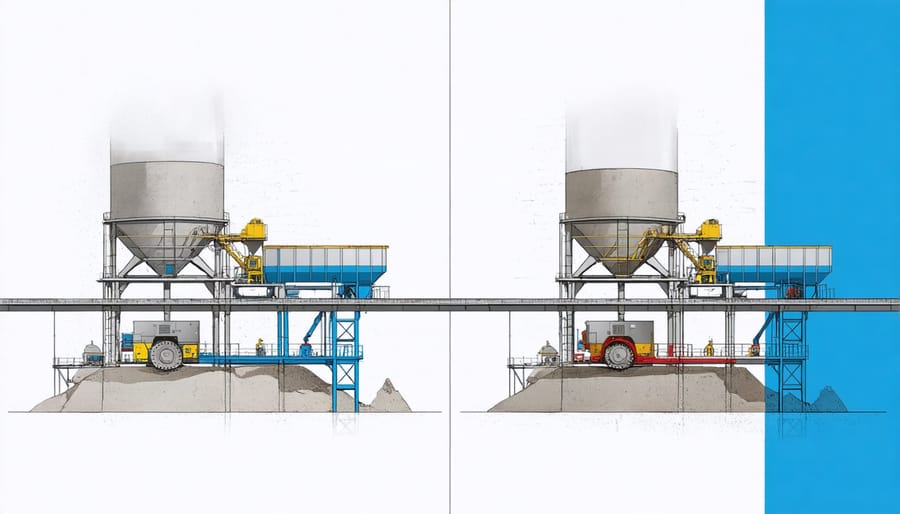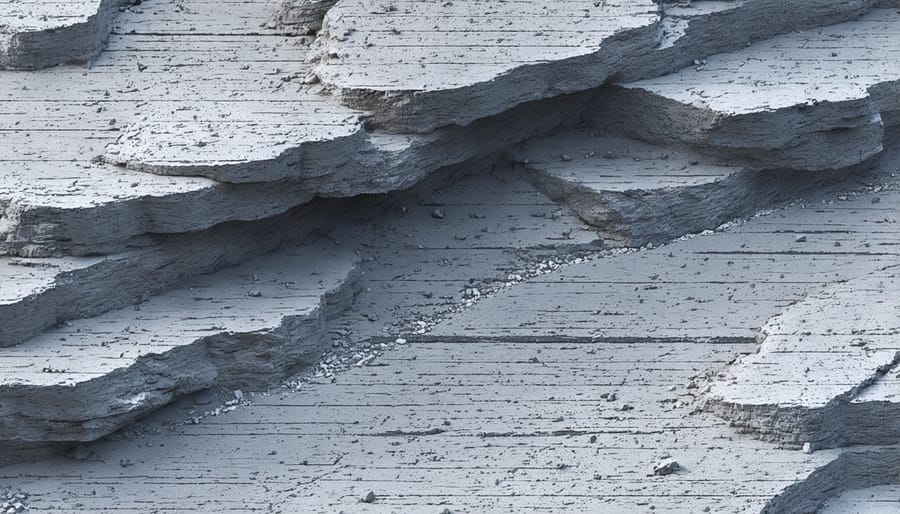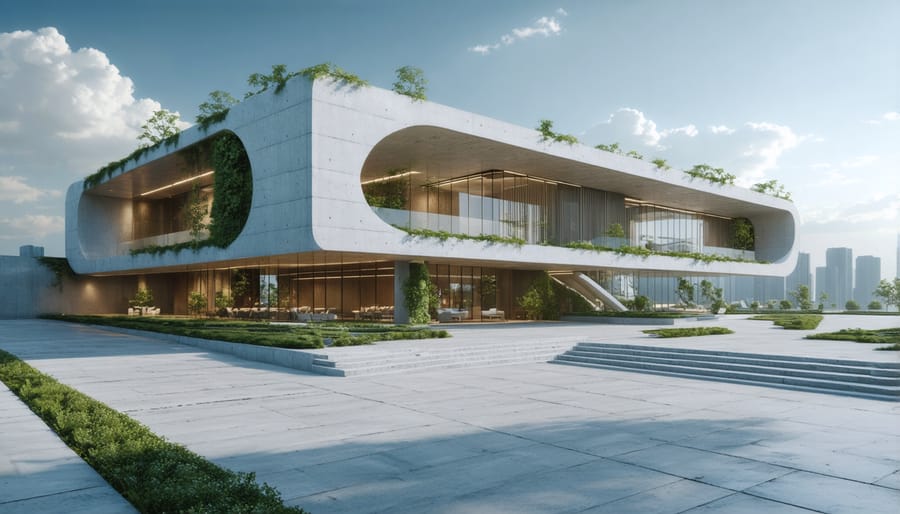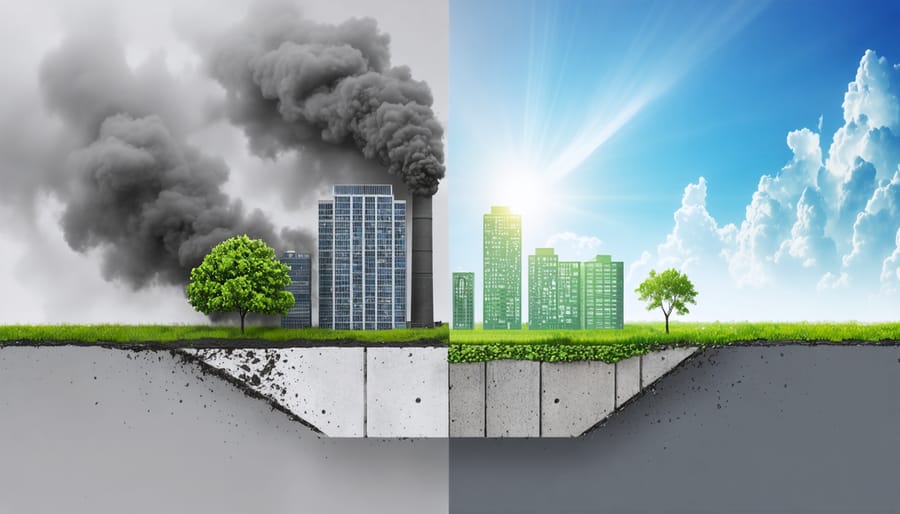As the construction industry pivots toward sustainable construction practices, low-carbon concrete emerges as a transformative solution in the battle against climate change. With traditional concrete production accounting for 8% of global CO2 emissions, this innovative alternative promises to revolutionize how we build our future infrastructure.
Recent advances in materials science have enabled the development of concrete mixtures that reduce carbon emissions by up to 70% while maintaining structural integrity. By incorporating industrial byproducts like slag, fly ash, and silica fume, these formulations not only minimize environmental impact but also often exhibit enhanced durability and performance characteristics.
However, the transition to low-carbon concrete presents both opportunities and challenges for industry stakeholders. While early adopters report significant environmental benefits and potential cost savings over time, concerns about initial investment, availability of materials, and code compliance must be carefully weighed. This comprehensive analysis explores the critical factors construction professionals need to consider when evaluating low-carbon concrete for their projects, examining both its promising advantages and practical limitations in today’s building landscape.

What Makes Concrete ‘Low Carbon’?
Alternative Cementitious Materials
Alternative cementitious materials (ACMs) play a crucial role in reducing the carbon footprint of concrete production. Ground Granulated Blast-furnace Slag (GGBS), a byproduct of steel manufacturing, can replace up to 80% of traditional Portland cement, potentially reducing CO2 emissions by 70% per cubic meter of concrete. Similarly, fly ash, recovered from coal-fired power plants, offers a viable cement replacement option with replacement rates typically ranging from 20-35%.
These supplementary cementitious materials not only decrease environmental impact but also enhance concrete performance. GGBS improves workability and reduces heat of hydration, making it particularly suitable for mass concrete applications. Fly ash contributes to better sulfate resistance and reduced permeability, extending the service life of concrete structures.
Other emerging alternatives include calcined clay, silica fume, and limestone fines. Recent innovations have introduced geopolymer binders, which can eliminate the need for Portland cement entirely. However, availability and regional supply chain constraints remain significant considerations when specifying these materials. Construction professionals must carefully balance environmental benefits with material accessibility and project requirements when selecting alternative cementitious materials.
Carbon Capture Technologies
Carbon capture technologies represent a significant breakthrough in reducing concrete’s environmental impact, serving as one of the most promising innovative construction technologies in recent years. The process typically involves two primary approaches: direct CO2 injection during mixing and mineralization through curing. During mixing, captured CO2 is introduced to fresh concrete, where it reacts with calcium ions to form calcium carbonate, effectively sequestering carbon while improving the concrete’s strength properties.
Mineralization technology, meanwhile, uses CO2 as a curing agent, creating a controlled environment where carbon dioxide is absorbed into the concrete matrix. This process not only reduces the carbon footprint but also accelerates strength development, potentially reducing curing times by up to 20%. Several commercial systems now exist that can capture and store CO2 emissions directly from cement production facilities, creating a closed-loop system that significantly reduces the industry’s environmental impact.
These technologies have demonstrated the potential to reduce concrete’s carbon footprint by 5-25%, depending on the specific application and implementation method. However, their effectiveness varies based on factors such as concrete mix design, environmental conditions, and available infrastructure for CO2 capture and storage.
The Advantages of Low Carbon Concrete
Environmental Benefits
Low carbon concrete stands at the forefront of environmental benefits of sustainable building, offering significant reductions in carbon emissions compared to traditional concrete mixtures. Studies indicate that low carbon concrete can reduce CO2 emissions by 30-70%, depending on the specific formulation and manufacturing process used. This substantial decrease stems primarily from the replacement of ordinary Portland cement with supplementary cementitious materials (SCMs) such as fly ash, slag, or silica fume.
The environmental impact extends beyond carbon reduction. Low carbon concrete often incorporates recycled materials and industrial by-products, effectively reducing landfill waste and promoting circular economy principles in construction. For instance, utilizing ground granulated blast furnace slag (GGBS) as a cement replacement not only reduces CO2 emissions but also repurposes waste from steel manufacturing.
Furthermore, low carbon concrete demonstrates enhanced durability in many applications, potentially extending structure lifespans and reducing the need for repairs or replacement. This longevity factor multiplies the environmental benefits over time, as fewer resources are required for maintenance and reconstruction throughout the building’s lifecycle.
Water conservation is another notable advantage, as many low carbon concrete formulations require less water during mixing and curing processes. This aspect is particularly significant in regions facing water scarcity challenges, making it an environmentally responsible choice for sustainable construction projects.
Performance Benefits
Low carbon concrete demonstrates impressive performance characteristics that often match or exceed those of conventional concrete. Testing has shown that many low carbon formulations achieve compressive strengths comparable to traditional concrete, typically ranging from 30 to 60 MPa, making them suitable for structural applications.
One notable advantage is enhanced durability due to the dense microstructure created by supplementary cementitious materials (SCMs) like fly ash and slag. These materials contribute to reduced permeability, making the concrete more resistant to chemical attack, chloride penetration, and carbonation. This increased durability can significantly extend the service life of structures, reducing long-term maintenance requirements.
The material also exhibits superior thermal mass properties, contributing to better energy efficiency in buildings. Studies have shown that structures built with low carbon concrete maintain more stable internal temperatures, potentially reducing heating and cooling costs by 10-15%.
Fire resistance is another area where low carbon concrete excels, with some formulations showing improved performance compared to traditional mixes. The material’s enhanced chemical binding properties often result in better resistance to high temperatures and slower heat transfer rates.
Additionally, low carbon concrete typically demonstrates reduced shrinkage and cracking potential due to lower cement content and optimized particle packing. This characteristic is particularly valuable in large-scale infrastructure projects where crack prevention is crucial for structural integrity and longevity.

The Challenges and Drawbacks
Cost Implications
The implementation of low carbon concrete typically involves higher initial costs compared to conventional concrete, with premiums ranging from 5% to 15% depending on the specific mix design and locally available materials. This cost differential primarily stems from specialized ingredients such as supplementary cementitious materials (SCMs), alternative binders, and advanced admixtures required for maintaining performance standards.
However, when evaluating cost-effective sustainability solutions, it’s crucial to consider the long-term economic benefits. Buildings utilizing low carbon concrete often qualify for green building certifications, tax incentives, and carbon credits, which can offset the initial investment. Furthermore, the enhanced durability and reduced maintenance requirements of many low carbon concrete formulations can lead to significant life-cycle cost savings.
Recent market analysis suggests that economies of scale and increasing demand are gradually reducing the cost premium. Projects in regions with established carbon pricing mechanisms or strict environmental regulations often find that low carbon concrete becomes economically competitive when factoring in potential carbon taxes or compliance costs. Additionally, as manufacturers scale up production and optimize manufacturing processes, the price gap between conventional and low carbon alternatives continues to narrow.
For large-scale projects, the cost implications can be mitigated through strategic sourcing, bulk purchasing agreements, and careful mix design optimization that balances performance requirements with available materials.
Technical Limitations
Low carbon concrete presents several technical challenges that construction professionals must carefully consider during project planning and execution. One primary concern is the extended curing time compared to traditional concrete mixtures. The incorporation of supplementary cementitious materials (SCMs) like fly ash or slag can slow down the early strength development, potentially affecting construction schedules and formwork removal timing.
Strength development patterns in low carbon concrete can be less predictable, particularly in cold weather conditions. While these mixes eventually achieve comparable or even superior strength to conventional concrete, the initial strength gain may be 20-30% slower in the first 7 days. This characteristic requires careful monitoring and potentially adjusted construction sequences.
Quality control presents another significant challenge. The performance of low carbon concrete is highly dependent on proper mix proportioning and material compatibility. Variations in SCM sources and qualities can affect consistency and workability, demanding more rigorous quality assurance protocols and experienced personnel.
Water demand and bleeding characteristics may differ from traditional concrete, requiring careful attention during placement and finishing. The reduced cement content can also impact the concrete’s pH level, potentially affecting reinforcement passivation in some applications. Additionally, carbonation resistance may be lower in certain low carbon formulations, necessitating careful consideration in exposed structural elements.
These technical limitations, while manageable with proper planning and expertise, require thorough understanding and appropriate adjustments to construction methodologies and quality control procedures.

Implementation in Modern Construction
Low carbon concrete is increasingly being adopted in major construction projects worldwide, demonstrating its viability as a sustainable building material. The One World Trade Center in New York incorporated over 110,000 cubic yards of low carbon concrete, achieving a 20% reduction in carbon emissions compared to traditional concrete while maintaining structural integrity.
In Europe, the Crossrail project in London exemplifies large-scale implementation, utilizing low carbon concrete throughout its underground stations and tunnels. The project achieved a 50% reduction in embodied carbon through innovative mix designs and supplementary cementitious materials.
Leading construction companies are establishing standardized practices for low carbon concrete implementation. Skanska’s Norway operations have made low carbon concrete their default option, reporting successful applications in both residential and commercial projects. Their data shows comparable costs to traditional concrete when considering the entire project lifecycle.
Several municipalities have also mandated low carbon concrete usage in public projects. Portland, Oregon’s Green Building Policy requires concrete with at least 30% supplementary cementitious materials in all public construction, setting a precedent for other cities.
Recent implementations have focused on optimizing mix designs for specific applications. The Copenhagen Metro expansion project developed different low carbon concrete formulations for various structural elements, demonstrating that tailored solutions can maximize both environmental benefits and performance requirements.
These real-world applications have generated valuable data on long-term performance, helping address initial industry skepticism. Monitoring reports from projects completed over the past decade show that properly specified low carbon concrete maintains durability and strength while delivering significant environmental benefits.
Low carbon concrete represents a significant step forward in sustainable construction, offering a viable solution to reduce the industry’s environmental impact while maintaining structural integrity. Through our analysis, we’ve seen that the primary advantages of reduced carbon emissions, comparable strength properties, and potential cost savings over time make it an attractive option for forward-thinking construction projects. However, the challenges of higher initial costs, limited availability, and the need for specialized knowledge cannot be ignored.
Looking ahead, the future of low carbon concrete appears promising. Ongoing technological advancements and increasing regulatory pressure to reduce construction-related emissions will likely drive wider adoption. Industry experts predict that improvements in manufacturing processes and growing market demand will help address current limitations, particularly regarding cost and availability.
For construction professionals considering the transition to low carbon concrete, the decision should be based on project-specific requirements, regional regulations, and long-term sustainability goals. As the industry continues to evolve and environmental considerations become paramount, low carbon concrete is positioned to become an increasingly important tool in sustainable construction practices, potentially becoming the new standard in the coming decades.

